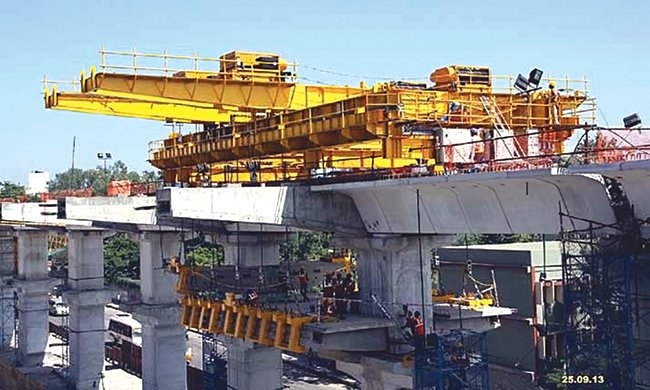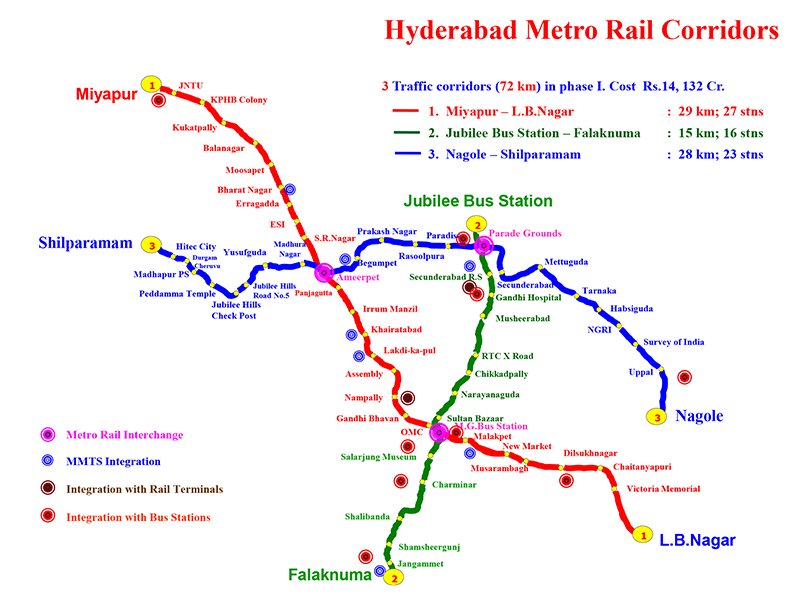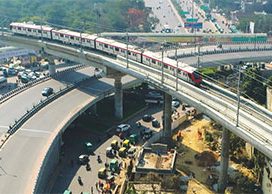A Unique Financial Model

Metro Rail projects need massive investment and take a long time to break even. Many incur losses for quite some time before they begin making profit. But HMR, which has a total project cost of र14,132cr, has a financial model that puts minimum burden on the taxpayers’ money and the government. Out of the total cost, just र1,458cr (10%) has been provided by the Union Government as one-time capital grant under Viability Gap Funding. The remaining र12,674cr is being raised entirely by the concessionaire L&T Metro Rail Hyderabad with 20% Equity (र2,768cr) and 70% of debt (र9,906cr). Thus 90% of the cost is being borne by the private sector partner of the project while 10% is financed by the Central government. The state government is bearing the cost of land acquisition, utility shifting, etc. The concessionaire will get an estimated 55% of its revenues from passenger fares. Another 40% has been estimated to come from lease revenues from the properties developed by L&T Metro Rail as a part of the Transit Oriented Development (TOD) project being developed at metro stations and other parts of the HMR corridors. The remaining 5% will be from sources such as advertisements and parking charges. L&T Metro Rail is being allowed to commercially exploit the air space over the metro rail facilities and TOD projects developed by it. For the duration of the Concession period, it will get the lease rentals from these properties developed by it, which will subsidise the losses from passenger operations.
The Concession Period for the project is 35 years, extendable by another 25 years, if the concessionaire meets all the requirements and conditions of the Concession Agreement. At the end of the Concession Period, the state government will get the ownership of the entire HMR project.
 One of the most common reasons Metro rail projects incur losses is the fact that the metro capacities are usually designed for peak hour peak density traffic (PHPDT). This causes losses during off-peak hours which see comparatively very less commuters. To overcome this problem, HMR has adopted a unique fare structure where peak hour commuters pay a higher fare, more than double, than off-peak hour commuters. The fare and fare escalation formula has been frozen for 15 years. The initial minimum fare has been set at
One of the most common reasons Metro rail projects incur losses is the fact that the metro capacities are usually designed for peak hour peak density traffic (PHPDT). This causes losses during off-peak hours which see comparatively very less commuters. To overcome this problem, HMR has adopted a unique fare structure where peak hour commuters pay a higher fare, more than double, than off-peak hour commuters. The fare and fare escalation formula has been frozen for 15 years. The initial minimum fare has been set at र8 and maximum र19 with six slabs. There is an allowance for a 5% increase each year for the first 15 years plus 60 per cent of Wholesale Price Index based inflation (in most projects, this is normally fixed at 50 per cent)
Transit Oriented Development
HMR will be the first metro rail project in the country to try out Transit Oriented Development (TOD) built around it. TOD, as the name suggests, focusses on creating vibrant urban communities centred around or integrated around a good quality mass transit system. It will reduce transportation costs significantly for companies, while relieving employees of the trauma of commuting to work in highly congested buses and trains, saving valuable time and enhancing quality of life. High frequency of trains will reduce waiting times. Retail establishments in the TOD zone would see a significantly larger number of visitors due to proximity to the metro station.
Hyderabad Metro Rail Project will transform Hyderabad into one of India’s most futuristic cities, with an integrated urban transport plan using inter-modal connectivity and convenient sky-walks. It is an iconic infrastructure project in offing. This project is expected to trigger robust economic activity in and around the city and will generate substantial employment.
The total potential for TOD development of HMR is 18.5 million square feet, with 12.5 million at the terminals and 6 million at the metro stations. L&T Metro Rail will develop facilities for a wide variety of sectors in the TOD areas – Office Spaces for IT/ITES and other companies, hotels, service apartments etc for the hospitality sector, educational facilities, hospitals, polyclinics for the healthcare industry, convenience retail stores at metro stations and a multitude of others – warehouses, convention centres, theme parks, entertainment zones etc. These facilities can be either customized for specific clients or can be multi-client facilities.
Project Consultants
• AECOM – Feedback Ventures Consortium – General Consultant• Parsons Brinckerhoff – Programme Manager
• Keolis – O&M Contractor
• Halcrow – Independent Safety & RAMS Accessor
• Ernst & Young – Consultant for Carbon Credit
• L&T Rambøll – Design & Traffic Consultant
• L&T Construction – Detailed Engineering
• Skyline Archon (Hyd) Private Limited – Traffic Management
• Louis Berger was appointed independent engineering consultant by L&T Metro, Hyderabad Metro Rail Limited and the then Government of Andhra Pradesh.
For the first phase of TOD, L&T Metro Rail has already initiated developments along six million square feet of space at important locations along the metro corridors and is spending about र2,243cr. The depots will have options for building large facilities & campus style developments while there will be convenience retail space at the metro stations. The depots and stations will become hubs of economic, social and educational activity in their own right. The generation of revenue by making metro stations hubs of a range of activities will make off-peak transit profitable for HMR.
“I am building a symbiotic relationship between the property developers and the ridership,” says Reddy. “The stations and surroundings become destinations. Malls, multiplexes, theatres, restaurants and food courts, social spaces – everything people want should be available near a metro station.”
 TrafficInfraTech Magazine Linking People Places & Progress
TrafficInfraTech Magazine Linking People Places & Progress


